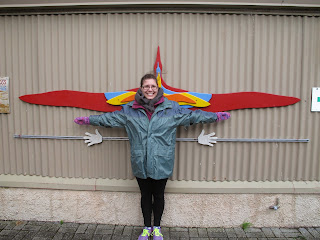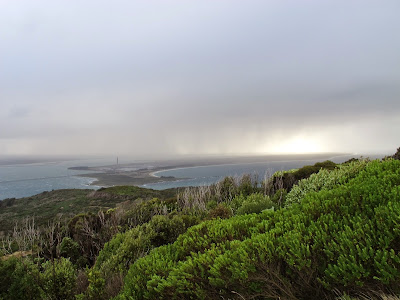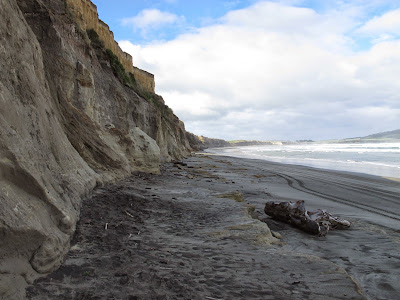A chilly night was broken by a very chilly morning. The increasing light was largely diluted by the clouds, rain and, to both our delight and disappointment, the snow. It was cold enough in the night that snow had fallen and stayed on the ground in elevated areas. With the heat blazing in the car, we left our little cabin and drove to our final Catlins destination on this trip.
In the parking lot for Nugget Point we were first greeted by a pelting of hail that quickly built up the windscreen of the car. Can you tell which of the two has recently been through a terrible winter in Canada?
The trail to Nugget point carved its way along the cliff side, which did provide beautiful views of blue-green water, rocky outcrops, and grey horizons. The occasional monolithic stone stood alongside the cliff as a prelude of what was to come.
At the end of the trail stood yet another lighthouse in the usual New Zealand architecture, warning of the treacherous rocks below. Although ancient sailing vessels no doubt would have seen this as a hazard, it was a delightful view for us, with this unique outcropping of eroded headland forming the numerous nuggets of rock. Great bull kelp swayed with the crashing tides revealing sea lions playing among them in the shelter of the rocks. We kept our eyes open for sharks which no doubt would target areas like this with high seal abundance, if they were present at all.
Tired after a long cold night and a busy day before, we kept our sightseeing to a minimum, and headed straight for Dunedin and out to Otago Peninsula to see our last creature destination. On the cliffs at the end of the peninsula, the only "mainland" Royal Albatross nesting ground can be found. At the time of year we were visiting, the parents only return infrequently to feed the chicks who were a large, white, fluffy ball of feathers. There were six chicks in view from the blind on the hill where we sat and we managed to get a good look at them as the moved around scratching their itching skin. In New Zealand, these endangered birds are kept relatively safe by a large predator fence and trapping that keeps rats, stoats, ferrets, possums, and cats from venturing in and harming either birds or eggs. Our knowledgeable guide also pointed out that many birds die from malnutrition, due largely to the immense amount of plastic the birds pick up out at sea. When you see how an entire plastic sandwich container full of plastic junk was taken from the stomach of one bird, it really shows how wasteful we are as a society.
We did see one juvenile who was flying around close by but we were unable get a good shot of him. The distance made it difficult to really judge the size of these birds, but fortunately there was a model on the way down that gave a good sense of scale. My beautiful model demonstrated how the close to 3 metre wingspan far outstretches most birds in New Zealand. We could also see some of these huge birds dancing on the winds, dipping and weaving on air currents in a majestic dance across the oceans surface.
Just before we left though, I checked out one last little beach to see if we could spot some more penguins. Much to my surprise there were numerous fur seals hauled out onto the grass flats and rocks, nearly having stepped on one. I backed off and grabbed Mary-Ellen to get a nice, up close view of these lethargic creatures. One was still playing in the water though, and reminded us of just how graceful these animals can be, a stark difference to their appearance on land.
The light soon faded and we checked into our cabin in Dunedin, enjoyed a nice cold taco salad, before heading back into town to get a coffee and dessert. With our heater running in the cabin, we jumped into our sleeping bags and settled into a much warmer sleep, only interrupted by the occasional downpour of hail on the tin roof.










































































